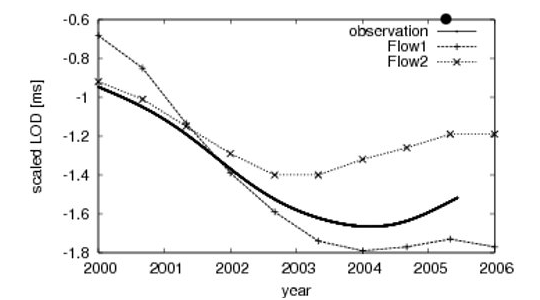The Earth's rotation rate varies with periods ranging from a few days to at least a few thousand years. Several geophysical processes affecting the Earth's rotation rate: exchanges of angular momentum between solid Earth and either the atmosphere or oceans, tidal friction in the gravitational Earth-Moon-Sun system, seasonal exchange of angular momentum due to foliation and glaciation, or changes in the moment of inertia of the mantle due to postglacial rebound. It is widely accepted that between core and mantle angular momentum is exchanged via several possible coupling mechanism. Because angular momentum is conserved an increase in the mantle rotation rate is associated with a slowing down of the core and vice versa. Small differences between universal time (UT) and ephemeris time (ET) can be measured through astronomical observations, e.g., the time of lunar occultation of a star can be predicted to a high accuracy. Small changes in the Earth rotation rate cause discrepancies between the predicted time and the actual time, this time lag can directly be translated into a sidereal displacement angle, which gives the relative position of the Earth to the stars. The first time derivative of the displacement angle time series is the variation in the length of day (LOD). The changes in LOD are equivalent to changes in the angular momentum. It has been shown that temporal changes in the core surface motion account for decadal changes in LOD. The estimation of changes in the core angular momentum requires only that the surface flow matches the bulk flow on tangential cylinders in the liquid outer core. However, this approximation fails on centennial and millennial time scales.



